EN 15259 Stationary Source Emission Testing in Industry
The European standard EN 15259 sets out a framework for stationary source emission testing. This method is crucial for ensuring compliance with regulatory requirements and maintaining environmental sustainability within industrial manufacturing processes. The standard provides guidelines to measure emissions from various types of stationary sources, including combustion equipment, boilers, incinerators, and industrial furnaces.
Stationary sources are installations that do not move or have a fixed position in relation to the process they serve. These sources emit pollutants directly into the atmosphere during normal operation. Accurate measurement is essential for compliance with environmental legislation such as the Industrial Emissions Directive (IED) and the Air Quality Standards Directive.
The testing process involves several critical steps, including sampling, analysis, and reporting of emissions data. Sampling must be conducted according to specific protocols outlined in EN 15259 to ensure reliable results. This includes selecting appropriate sampling points that represent the entire emission source. Once sampled, the gases are analyzed using various analytical techniques tailored for detecting different pollutants.
Key pollutants targeted by this standard include sulfur dioxide (SO₂), nitrogen oxides (NOₓ), particulate matter (PM), and volatile organic compounds (VOCs). The results of these analyses provide insights into potential environmental impacts, helping industries identify areas where improvements can be made to reduce emissions. Reporting must follow strict criteria set forth in the standard, ensuring transparency and traceability.
Implementing EN 15259 emission testing offers numerous benefits for industrial facilities. It helps organizations stay ahead of regulatory changes by providing early warning signals regarding potential non-compliance issues. Additionally, it supports continuous improvement initiatives aimed at reducing environmental footprints through better process management practices.
In summary, adhering to the requirements specified in EN 15259 ensures that industrial plants operate efficiently while minimizing adverse effects on air quality and public health. By adopting this approach, companies not only meet legal obligations but also enhance their reputation as responsible stewards of natural resources.
Scope and Methodology
| Aspect | Description |
|---|---|
| Emission Sources Covered | The standard applies to a wide range of stationary sources including boilers, combustion equipment, incinerators, and industrial furnaces. |
| Sampling Techniques | Involves selecting representative points for sampling based on the nature and characteristics of the emissions. |
| Analytical Methods | Includes various techniques such as gas chromatography (GC), Fourier transform infrared spectroscopy (FTIR), and other relevant technologies. |
| Data Reporting Requirements | Details on how results should be documented, including formats and submission deadlines. |
The scope of EN 15259 emission testing encompasses all aspects from initial planning stages through final reporting. It ensures that every step in the process adheres to best practices recognized internationally for accurate measurement and reliable data collection.
Eurolab Advantages
At Eurolab, our commitment to excellence in industrial air quality testing is reflected in the comprehensive services we offer. Leveraging cutting-edge technology and experienced professionals, we provide precise measurements that meet or exceed industry standards like EN 15259.
We employ state-of-the-art instrumentation capable of detecting even trace amounts of pollutants. Our laboratories are equipped with high-performance analyzers designed specifically for analyzing emissions from different types of stationary sources. This allows us to deliver accurate results consistently, regardless of the complexity or variability of the sample.
In addition to technical proficiency, Eurolab prioritizes customer satisfaction by offering flexible scheduling options that fit into busy operational calendars without disrupting production schedules. Our team members are fully trained and certified in accordance with relevant international standards such as ISO/IEC 17025, ensuring they can handle diverse samples effectively.
Our approach goes beyond mere compliance; it focuses on helping clients understand their emission profiles better so that proactive measures can be implemented to reduce emissions further. By providing detailed reports accompanied by recommendations for improvement whenever necessary, we empower companies towards sustainable development goals.
Customer Impact and Satisfaction
Adopting EN 15259 emission testing practices has tangible impacts on customer satisfaction across multiple dimensions:
- Regulatory Compliance: Ensures adherence to stringent environmental regulations, thereby avoiding penalties associated with non-compliance.
- Economic Benefits: Identifies inefficiencies early on which leads to cost savings through optimized operational practices.
- Social Responsibility: Demonstrates commitment to protecting public health and improving overall air quality within local communities.
- Risk Mitigation: Provides a systematic way of identifying risks related to emissions, allowing for timely interventions before they escalate into larger problems.
Customer feedback consistently highlights Eurolab's ability to deliver reliable test results backed by robust documentation. This has earned us a reputation for delivering high-quality services that contribute significantly towards achieving organizational objectives while maintaining ethical standards.





